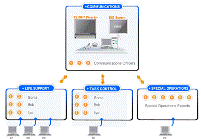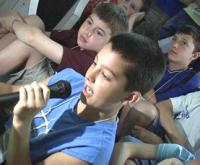|
Welcome to the Satellite Rescue live simulation
web site. Here, you will find everything you
need to run this simulation effectively in your
classroom.
What is the Satellite
Rescue live simulation?
Satellite Rescue is a live “mission”
conducted in your classroom through
videoconferencing. It features teams of students
using real-time data to complete the mission
directive. The accompanying web site provides
5-10 class periods of mission preparation
materials, including the standards addressed,
scope and sequence, lesson plans, and student
materials.
Is this only for math
classes?
Satellite Rescue was created to reinforce
certain math concepts for grades 5-8:
-
Solving for missing
values in proportions to calculate heart,
respiration, and oxygen usage rates for each
astronaut.
-
Graphing data to make
predictions about astronaut exertion levels.
-
Using problem solving to
find solutions to logistical issues during
the mission.
The program is an innovative
way to engage students by integrating both math
topics and authentic space science in a
real-time context. The web site includes
resources for integrating science topics.
How is the program used?
| Schedule date → |
Brief the students
→ |
Math lessons → |
Pre-mission prep → |
Conduct the mission |
-
Schedule a mission date
with NASA’s Digital Learning Network.
-
Brief the students on
the mission NASA is asking them to conduct.
-
Use lesson plans
provided on the web site to reinforce the
relevant math concepts.
-
Prepare students for the
mission by completing a “mini-mission” to
apply math concepts.
-
Link with the DLN;
conduct mission!
 In
what way is the simulation conducted in
realtime? In
what way is the simulation conducted in
realtime?
The mission is a student-centered,
team-based, interactive educational experience
that makes use of scientifically accurate data
to solve problems. Teachers run the simulations
in their own classrooms through the Internet
using a small video camera, or they use nearby
distance learning labs. The classroom is
connected with a mission director from NASA who
guides the problem-solving activities to a
successful conclusion.
In the Satellite Rescue
simulation students work on the life support,
task control, special operations, or 0communicators in teams
as part of mission control.
All teams perform a specific function and work
together to monitor each astronaut's vital
signs, task itinerary, and oxygen supply during
an extravehicular activity, or EVA. As
logistical problems arise during the EVA, the
special operations team must use problem solving
to help the astronauts complete the mission.
Communicators coordinate all these activities
with the space shuttle mission commander.
 Is
this just for fun or do students really learn? Is
this just for fun or do students really learn?
The program was designed by middle and high
school teachers, educational researchers, and
subject matter experts Satellite Rescue joins
the lineup of innovative distance learning
programs offered by NASA's Digital Learning
Network and the Center for Educational
Technologies. Simulations are an interactive way
for you to effectively use technology in your
classroom. Research indicates that this way of
learning leads to improved problem-solving and
critical-thinking skills and teaches students
the importance of teamwork and communication.
Shifting to digital learning
is critical to the success of education in
America. Satellite Rescue creates an opportunity
for you to apply various technologies and
provides necessary digital content lacking in so
many computer classrooms.
Good luck on your mission!Download
Microsoft Active Accessibility. |


